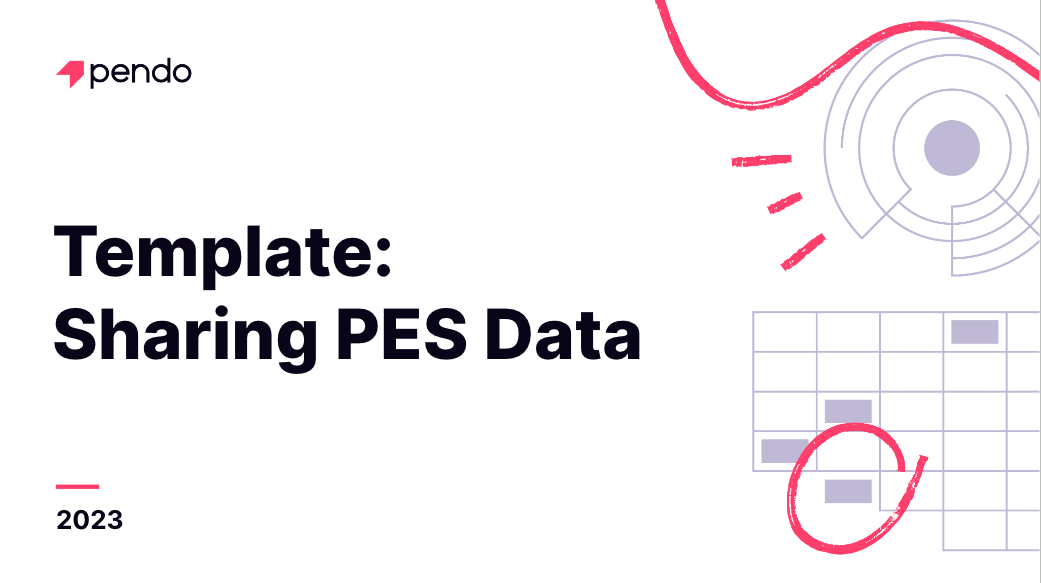ソフトウェア企業(最近ではほとんどすべての企業がそうですが)の取締役会に出席したことはありますか?もし出席したことがある場合、それがどのようなものだったかを思い出してみてください。どのような指標が提示され、議論されましたか?会話が年間経常収益(ARR)、売上維持率(NRR)、顧客獲得コスト(CAC)、解約率などに集中していたのではないでしょうか。
これらの指標はビジネスパフォーマンスの重要な指標ではありますが、実際には全体像のごく一部しか表していません。さらに重要なのは、これらの数字を把握したところで、通常はその数字に影響を与えるようなアクションを起こすには遅すぎるということです。
ある四半期に、収益予測が外れてしまった場合のシナリオを考えてみましょう。次に何が起こるでしょうか?パイプラインを強化し、マーケティング費用を最適化することはできますが、軌道修正できるようになるまでにはおそらく数か月かかります。
先行指標と遅行指標
言い換えれば、ビジネスや財務の指標は遅行指標であり、過去のパフォーマンスを測定するものです。顧客の解約や収益低下などに先手を打つには、より短い時間枠で測定可能、かつ将来のパフォーマンスを示す先行指標を追跡する必要があります。
ソフトウェア企業にとって重要な先行指標は、プロダクトの使用状況です。プロダクトの使用率が下がっている場合、顧客満足度の低下、あるいは顧客の解約の可能性を示すシグナルとなりえます。プロダクトの長期的な使用状況、機能の定着率、ワークフローの完了状況などのデータポイントは、プロダクトの摩擦点や問題点を、手遅れになる前に警告するサインになります。
とはいえ、特にビジネスパフォーマンスを報告する場合、企業は先行指標と遅行指標の両方を追跡する必要があります。ビジネスや財務の指標とプロダクトの使用状況の指標を組み合わせることで、成果につながる優れたプロダクトを開発することができるようになります。
しかし、これだけ多くのプロダクトの使用状況に関する指標がある中で、どの指標に注目すべきでしょうか?そこで活用できるのが、プロダクトエンゲージメントスコア(PES)です。
プロダクトエンゲージメントスコア(PES)とは?
プロダクトエンゲージメントスコア(PES)は、プロダクトの健全性を理解する上で重要な3つの指標である定着率、粘着率、成長率の平均値を算出する複合的な指標です。PESは、プロダクトリーダーがプロダクトエンゲージメントを1つの数値に集約し、プロダクトのパフォーマンスをすばやく診断できるようにするために、弊社のプロダクトチームが作成したものです。PESが時間の経過とともに変化した場合、チームは各要素を掘り下げて、変化の原因を理解することができます。
ここでは、PESで使用される3つの指標の概要を説明します。
定着率:プロダクトの主要機能の使用状況や「アハ体験」を測定する、ユーザーの活性化指標です。PESでは、定着率はコアイベントとも呼ばれる主要フィーチャー(機能)がアクティブな訪問者またはアカウントに定着した数の平均を使うことで得られます。
粘着率:これは、プロダクトを定期的に再利用するユーザーの数を測定し、次の3つの方法で計算できます。
-
- 月別ユーザーの再訪問日別比率(DAU/MAU)
- 週別ユーザーの再訪問日別比率(DAU/WAU)
- 月別ユーザーの再訪問週別比率(DAU/WAU)
成長率:これは、ユーザーの成長率、定着率、解約率を考慮したQuick Ratio(当座比率)を使って、プロダクトがどれだけ効率的に成長しているかを説明するものです。
PESを使用してデータに基づく意思決定を行う
PESは、プロダクトエンゲージメントを明確に測定するだけでなく、意思決定に役立つ情報としても特に有効です。PESを使えば、開発リソースをどこに投資するか、どの機能を廃止するか、チームの作業をどこに集中させるかなど、プロダクトおよびビジネスの意思決定をデータに基づいて行うことができます。
プロダクトエンゲージメントスコアを使用して意思決定を行う場合、データが実際に何を伝えているのかを考えることが重要です。考慮すべきいくつかの例を次に示します。
-
- 定着率が低い:定着率が低い、または低下している場合は、ユーザーがこれらの重要なフィーチャーを使っていない理由を特定します。フィーチャーをもっと発見しやすくする必要があるのでしょうか?タスクやワークフローを説明するアプリ内ガイドを作成する必要があるでしょうか?また、オンボーディング体験を再検討することも有効です。オンボーディング中に、プロダクトの最も重要なフィーチャーを紹介していますか?していない場合は、ぜひ紹介しましょう。
- 粘着率が低い:粘着率が低い場合は、一度プロダクトを使った人が定期的に利用していないということであり、ユーザー体験に投資する必要があることを示すサインである可能性があります。また、顧客対応チームに連絡を取り、特定のアカウントで何が起きて粘着率が低下しているのかを理解することも必要かもしれません。
- 成長率が低い:成長率の低迷や停滞が見られる場合、プロダクトポートフォリオの刷新や拡大が必要であることが示唆されています。たとえば成長が鈍化している業界で大きなシェアを持つプロダクトがあり、その市場が頭打ちになっている場合です。成長の見込みがないプロダクトに全リソースを割くことは避けたいため、このような場合にPESのデータは、新プロダクトの開発に投資すべきという提案を裏付けるものとなります。
Pendoをご利用のお客様は、PendoアカウントにPESがすでに設定されており、すぐにアクセスできます。PESのデータを、ユーザーレベルやアカウントレベルで時系列で表示できるため、各要素を掘り下げて、プロダクトエンゲージメントをさらに詳しく知ることができます。さらに、このデータを使用して行動を起こし、プロダクトを改善して、ビジネス全体に影響を与えることができます。
-



